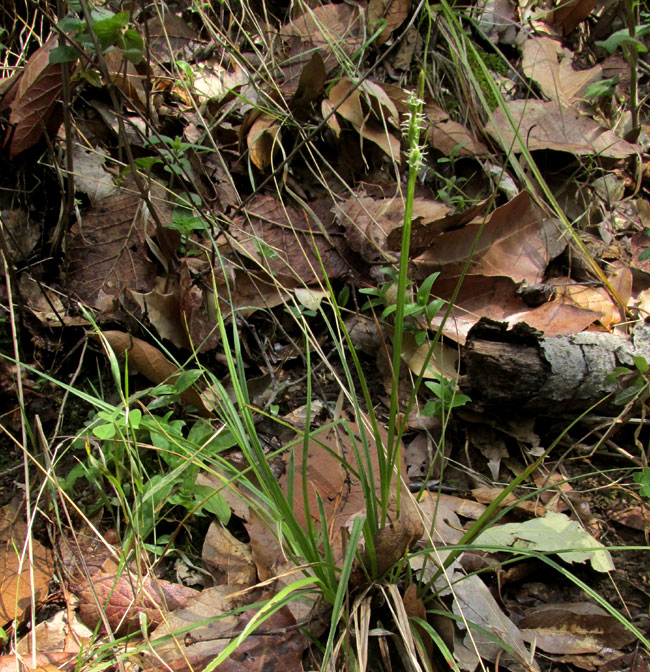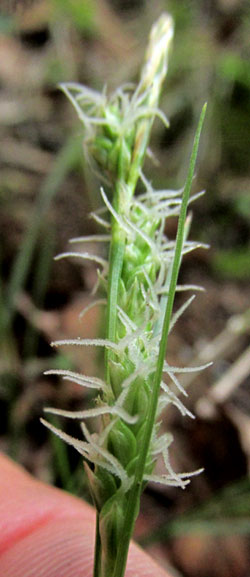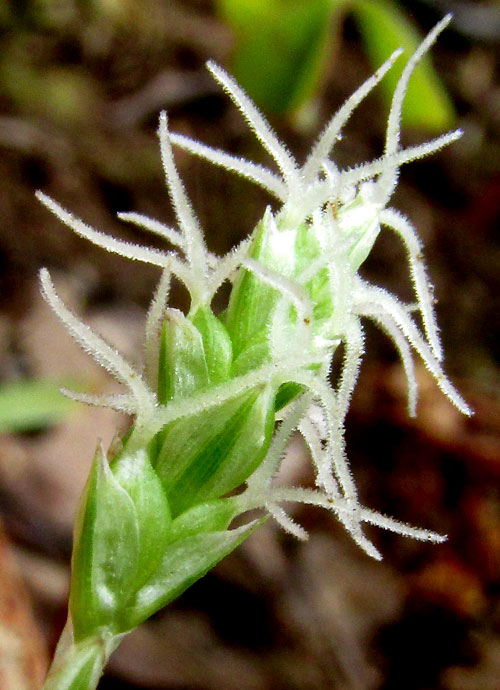Excerpts from Jim Conrad's
Naturalist Newsletter
entry from field notes dated July 2, 2022, taken on the eastern lower slope of Cerro de la Cruz, at an elevation of ~2700m (~8850 ft), just south of the community of El Pinar, Amealco de Bonfil, Querétaro, MÉXICO, (~N20.17°, ~W100.17°)
CAREX cf. LONGICAULIS


In the oak forest mantling the steep, lower eastern slope of Cerro de la Cruz, the above sedge, genus Carex, of the big Sedge Family, the Cyperaceae, grew on a steep slope where a tree had been cut down, leaving a hole in the canopy allowing some midday sunlight. It was clearly a Carex because, as seen at the right, its flowering head consisted of four or five short spikes of female flowers arising from the rachis's sides -- in the picture, three white, long styles arise atop each flower -- with a slender spike of male flowers terminating the rachis.
The genus Carex, which comprises about 2000 species worldwide, is one of the largest genera of all vascular plants. Most species prefer moist to wet habitats. In the Arctic, often they're abundant, but in deserts they're absent or rare. Often in eastern US forests over twenty species can be found on a single morning hike. Here in upland central Mexico the semiaridness discourages sedges, but in mountainous, wooded valleys it's better for them.
Especially because so many species exist, Carex identification can be hard. Apparently no one has seriously tackled the sedges of this part of Mexico. However, the Flora of Veracruz is available for that state, plus there's Fredrick J. Hermann's 1974 "Manual of the genus Carex in Mexico and Central America," otherwise known as US Dept. of Agriculture Agriculture Handbook no. 467. Both of those are freely available on the Internet, and both led me to the same best bet as to our sedge's identity.

Above, noteworthy features include the broad width of the sharply pointed, scale-like bracts subtending each flower, and the bracts' green midribs with wide, semitransparent sides. Each flower's three, long, fuzzy styles arise atop a short neck extending from the top of an achene-type fruit (dry, one seeded, doesn't split) completely enclosed and hidden by a green, bladder-like covering called the perigynium. The style neck exits the perigynium through a hole at the perigynium's top. In our species the hole is slightly two-toothed, and that's a good field mark, because often perigynia tops have long teeth. Also notable is that the perigynia are hairless, and show no hint of a slender neck atop them, found on many species.
These features and more, in both published sources, led me to Carex longicaulis, but I'm filing this page on the Internet under CAREX cf. LONGICAULIS, the cf. for "confirm," since there's some uncertainty. For example, the above picture isn't sharp enough to be sure that no very short, sparse hairs cover the perigynia, plus I don't know the exact length of the perigynia. However, Hermann's Manual describes Carex longicaulis as occurring in this region -- Hidalgo and Guanajuato south to Oaxaca -- and is "Frequent to locally common on dry, open slopes, and open woods, 6,000 to 11,000 ft," which describes our location pretty well. That elevation is 1800-3400m.
The Flora of North America remarks that "Considering the size and widespread occurrence of Carex, the rather limited economic utility of the genus is surprising." But then it goes on to say that Carex species are important constituents of many peat deposits, and in moist to wet habitats often are eaten by livestock and wildlife. Often they are regarded as having a high forage value. The implication is that those large migrations of caribou and moose we hear about are largely powered by solar energy stored in Carex bodies. So the bears and wolves who feed on caribou and moose also are Carex powered. On and on the connections can be made, with Carex species being keystone ecosystem species because of all the solar energy they have stored in their cumulative bodies, free for the eating.
Someday people will start thinking in terms of such services, not automatically in terms of "economic utility," but rather as "utility for Life on Earth."